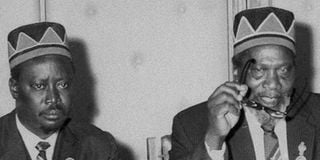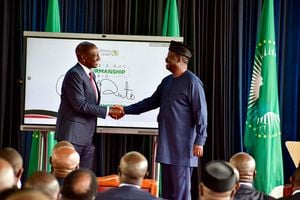
Mzee Jomo Kenyatta (left) with then Vice President Jaramogi Oginga Odinga.
In September of 1978, scarcely a month following the passing of Jomo Kenyatta, Jaramogi Oginga Odinga issued a public communiqué endorsing Daniel arap Moi as Kenyatta’s rightful successor in a rather unforeseen move.
In his widely forgotten statement, Jaramogi implored the Kenyan populace to rally behind Moi, citing the “interests of the nation” as paramount while extolling Moi’s legacy as one of the country’s pioneering nationalists.
To those familiar with Jaramogi’s political trajectory, this marked an intriguing turn of events. At its core, this overture seemed a reconciliatory gesture aimed at reclaiming relevance within the political mainstream.
How the Odinga family plays these conciliatory politics has a long history, but I will only deal here with that particular episode, for it informed his future dalliance with Moi – and that of his son Oginga Odinga.
My argument here is that supporting Moi was a way for Jaramogi to possibly rebuild his influence in the political sphere after years of exclusion – and allow Odingaism to thrive unperturbed.
Three months earlier, an abortive meeting was scheduled for State House, Nakuru, in which Jaramogi was to meet with Jomo Kenyatta, the first after so many years in political darkness.
Interestingly, according to secret US cables, the meeting – as per Jaramogi advisers – was sandbagged by Moi and the Nyanza Provincial Commissioner Isaiah Cheluget. Then Kenyatta passed away without meeting Jaramogi, forcing him to change his survival tactics.
In his secret communication with some US contacts, Jaramogi’s son-in-law, Otieno Ambala, claimed that Moi had sabotaged the Nakuru meeting, advising Kenyatta that a parley between Luos and him “would smack of tribalism”.
According to Ambala, Moi, then the vice-president, had threatened to resign unless Kenyatta agreed to receive a delegation from the entire Nyanza Province and not only Luos. He also told his US contacts that if he got power, Moi hoped to “isolate the Luos and Kikuyus and rule Kenya with an alliance of small tribes”.
But the US Ambassador, William Le Pelle, dismissed this view, commenting that while they could not doubt Ambala’s story on Moi’s determination to keep Luos in the periphery, the US Embassy doubted the claim that Moi had threatened to resign.
In a note to the Department of State, Le Pelle, dated May 15, 1978, held that “Moi treats Kenyatta with utmost diffidence and would not dare push his opinions or threaten to resign. Our view is that Kenyatta still makes his own decisions in these matters and, as he has done throughout his political life, keeps his reasons to himself and everybody else guessing.”
Building coalitions was a risky venture, as Ambala found. As the organiser of the meeting, Ambala later claimed that he was then picked up by police on April 13 while in Nakuru and incarcerated in Kisumu for 11 days without formal charges. He was also intimidated by Special Branch officers, and as he said, Moi was determined to “lock up” the Luo leaders if he came to power.
And that was why the Jaramogi post-Kenyatta strategy was interesting. Jaramogi, the old doyen of opposition politics, was strategic in power-play. But at times, he goofed so badly and would see his followers ostracised, thrown out of the government and, once upon a time, in detention.
Raila Odinga, who inherited the Odingaism mantle, must have picked his father’s script and played by the rules. For that, his politics remain a good case study of the dynamism of African politics. The Odingas are not static opposition figures, and how they have reconfigured national politics is beyond imagination.
This week, in a clear about-turn, the new Orange Democratic Movement leader, Prof Peter Anyang’ Nyong’o, asked party members to support President William Ruto’s “broad-based” government – an indicator that the opposition party would wish to be in the corridors of power as an active participant.
The recent dalliance between Raila Odinga and President Ruto and the support he is getting in his campaign for the African Union seat is a replay of his father’s desire to be relevant when the political chips are down. Odingaism is patrimonial and will be with us as a mobilisation tool.
Whether the rise of Anyang Nyong’o at the helm of ODM is also the end of Odingaism – as we knew it – is a topic that should concern historians and political scientists. But for the first time, the House of Jaramogi is not leading the main political party in the region – though Raila’s ghosts and Odingaism will continue to hoover over the party structures. For how long, we don’t know.
The Odingas know that power not achieved at the ballot box can be grabbed through secret State House deals. It is not a new thing. On September 10, 1978, before Jaramogi issued the statement supporting Moi, he had been to State House, Nairobi, where he had a private “ten minutes” meeting, according to US cable records.
The US embassy attributed the fact to Odinga’s “close adviser” Otieno Ambala. The advisor said that by extending his support, Odinga was hopeful that the marginalised Luo community would be accorded a “rightful political role in the future.”
Ambala was not the only voice that had been urging Jaramogi to make such a statement. The US political Affairs desk had been told by Onyango Midika that there was a need for cooperation with the post-Kenyatta government and that the Odinga camp had at first been contacted by the Minister of State Mbiyu Koinange and the Gikuyu Embu and Meru Association’s chairman, Njenga Karume “to discuss future cooperation.”
But Odinga, with some good foresight, dismissed the Gema group as having “no political future” and said that the “Family was unpopular.” The Family was in reference to the power barons who had initiated the Change-the-Constitution move to deny Moi the chance to succeed Kenyatta. He was right.
To get Jaramogi back into mainstream politics, Ambala confided with the Americans that he had “gotten Odinga to clear all his statements with him as he is apt to go off half-cooked and do more harm than good.”
Part of the push by Ambala and Midika, according to the Cables, was for the removal of the Nyanza Provincial Commissioner Isaiah Cheluget and the “establishment” ministers Isaac Omolo Okero, Mathews Ogutu and Robert Ouko as they did “not represent Luo people.”
That was a tall order – though some individuals can be sacrificed in politics. Recent events between Ruto and Raila attest to that.
The US Embassy had its analysis of the events that were shaping up. According to US Ambassador to Kenya, Wilbert J. Le Melle, in a cable dated September 12, 1978, while Luo leadership had publicly supported Moi, it was clear that they expected “some quid pro quo” and were “fearful that Charles Njonjo, as power behind Moi, will block any accommodation toward them.”
He added that it was “extremely interesting to note that politicians such as Ambala and Midika have come to realise that Odinga is now a hindrance to Luo political rehabilitation. They have spent many years in the wilderness with Odinga and now hope that an opening for them may be close at hand, if they can rid themselves of the Odinga liability.”
That could be said of Raila Odinga, who is under pressure from the young generation, who see him as a hindrance. One of the worries that Americans had —and perhaps many others — was whether the Luo block would survive “without the charismatic Odinga.”
How Odingaism, which has been with us since the 1970s, will thrive will depend on how Prof Nyongo organises the party along the politics of Jaramogi. While some critics consider Odingaism a personality cult, others say it represents the principles of the late Jaramogi Oginga Odinga, especially in negotiating power.
Certainly, it has metamorphosed from what Kenyatta University scholar Prof Henry Mwanzi called “mental and psychological” control of the Luo into a dynamic political unit where the elite negotiates their claims.
Recent negotiations for political power, in which senior ODM figures joined the Ruto cabinet, illustrate that Odingaism, as a negotiating tool, has come of age.
@Johnkamau1









